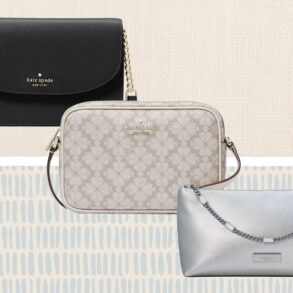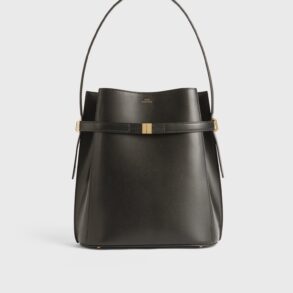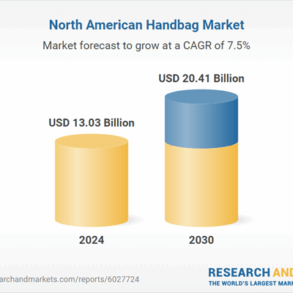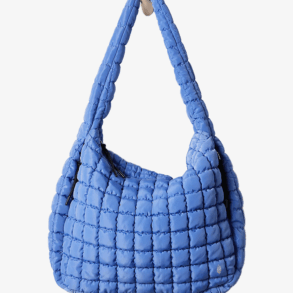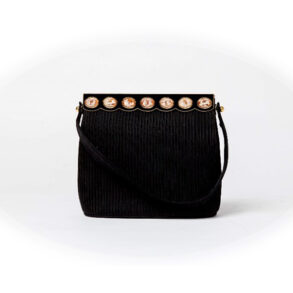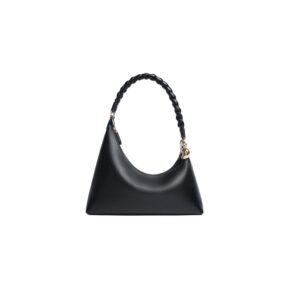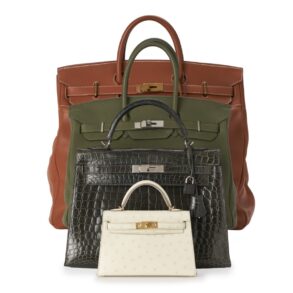May 18, 2025
IndexBox has just published a new report: China – Handbags – Market Analysis, Forecast, Size, Trends And Insights.
The handbag market in China is expected to experience a slight increase in performance, with a projected CAGR of +0.8% in volume and +1.5% in value from 2024 to 2035. By the end of 2035, the market volume is estimated to reach 715M units while the market value is projected to reach $2.6B in nominal prices.
Market Forecast
Driven by rising demand for handbag in China, the market is expected to start an upward consumption trend over the next decade. The performance of the market is forecast to increase slightly, with an anticipated CAGR of +0.8% for the period from 2024 to 2035, which is projected to bring the market volume to 715M units by the end of 2035.
In value terms, the market is forecast to increase with an anticipated CAGR of +1.5% for the period from 2024 to 2035, which is projected to bring the market value to $2.6B (in nominal wholesale prices) by the end of 2035.

Consumption
China’s Consumption of Handbags
In 2024, consumption of handbags decreased by -12.9% to 654M units, falling for the second consecutive year after two years of growth. Over the period under review, consumption saw a perceptible reduction. As a result, consumption attained the peak volume of 967M units. From 2023 to 2024, the growth of the consumption remained at a somewhat lower figure.
The size of the handbag market in China shrank to $2.2B in 2024, waning by -12.4% against the previous year. This figure reflects the total revenues of producers and importers (excluding logistics costs, retail marketing costs, and retailers’ margins, which will be included in the final consumer price). In general, consumption continues to indicate a pronounced contraction. Handbag consumption peaked at $3.3B in 2022; however, from 2023 to 2024, consumption remained at a lower figure.
Production
China’s Production of Handbags
In 2024, the amount of handbags produced in China rose to 2.9B units, increasing by 2% on the year before. Overall, production, however, continues to indicate a slight decrease. The pace of growth was the most pronounced in 2016 when the production volume increased by 138% against the previous year. As a result, production attained the peak volume of 7.3B units. From 2017 to 2024, production growth failed to regain momentum.
In value terms, handbag production expanded to $9.9B in 2024 estimated in export price. In general, production, however, showed a slight reduction. The most prominent rate of growth was recorded in 2016 when the production volume increased by 75% against the previous year. As a result, production reached the peak level of $18.5B. From 2017 to 2024, production growth remained at a lower figure.
Imports
China’s Imports of Handbags
In 2024, purchases abroad of handbags increased by 5.8% to 18M units for the first time since 2021, thus ending a two-year declining trend. In general, imports continue to indicate a buoyant increase. The most prominent rate of growth was recorded in 2014 with an increase of 26%. Over the period under review, imports reached the peak figure at 20M units in 2021; however, from 2022 to 2024, imports failed to regain momentum.
In value terms, handbag imports contracted to $4.3B in 2024. Overall, imports posted a buoyant expansion. The pace of growth appeared the most rapid in 2021 with an increase of 55%. As a result, imports reached the peak of $5.1B. From 2022 to 2024, the growth of imports remained at a lower figure.
Imports By Country
In 2023, France (11M units) constituted the largest handbag supplier to China, accounting for a 67% share of total imports. Moreover, handbag imports from France exceeded the figures recorded by the second-largest supplier, Vietnam (3M units), fourfold. Italy (2.4M units) ranked third in terms of total imports with a 14% share.
From 2013 to 2023, the average annual growth rate of volume from France stood at +23.6%. The remaining supplying countries recorded the following average annual rates of imports growth: Vietnam (+21.6% per year) and Italy (+14.2% per year).
In value terms, Italy ($2.1B), France ($1.6B) and Vietnam ($201M) constituted the largest handbag suppliers to China, together accounting for 82% of total imports. Cambodia, Indonesia, the Philippines, South Korea, the United States, Bangladesh and India lagged somewhat behind, together accounting for a further 9.6%.
Cambodia, with a CAGR of +99.8%, saw the highest growth rate of the value of imports, among the main suppliers over the period under review, while purchases for the other leaders experienced more modest paces of growth.
Imports By Type
In 2024, handbags with outer surface of plastic sheeting or of textile materials (14M units) constituted the largest type of handbags supplied to China, accounting for a 76% share of total imports. Moreover, handbags with outer surface of plastic sheeting or of textile materials exceeded the figures recorded for the second-largest type, handbags with outer surface of leather, composition leather, or patent leather (4.3M units), threefold.
From 2013 to 2024, the average annual rate of growth in terms of the volume of handbags with outer surface of plastic sheeting or of textile materials imports amounted to +10.6%. With regard to the other supplied products, the following average annual rates of growth were recorded: handbags with outer surface of leather, composition leather, or patent leather (+10.1% per year) and handbags with outer surface of vulcanised fibre or of paperboard (-2.0% per year).
In value terms, handbags with outer surface of leather, composition leather, or patent leather ($2.3B), handbags with outer surface of plastic sheeting or of textile materials ($2.1B) and handbags with outer surface of vulcanised fibre or of paperboard ($2.1M) were the most imported types of handbags in China, with a combined 99.9% share of total imports.
Handbags with outer surface of plastic sheeting or of textile materials, with a CAGR of +22.1%, saw the highest rates of growth with regard to the value of imports, in terms of the main product categories over the period under review, while purchases for the other products experienced more modest paces of growth.
Import Prices By Type
In 2024, the average handbag import price amounted to $248 per unit, which is down by -13.6% against the previous year. In general, the import price, however, continues to indicate measured growth. The pace of growth was the most pronounced in 2020 an increase of 43% against the previous year. Over the period under review, average import prices attained the maximum at $287 per unit in 2023, and then contracted in the following year.
There were significant differences in the average prices amongst the major supplied products. In 2024, the product with the highest price was handbags with outer surface of leather, composition leather, or patent leather ($538 per unit), while the price for handbags with outer surface of vulcanised fibre or of paperboard ($100 per unit) was amongst the lowest.
From 2013 to 2024, the most notable rate of growth in terms of prices was attained by handbags with outer surface of plastic sheeting or of textile materials (+10.4%), while the prices for the other products experienced more modest paces of growth.
Import Prices By Country
The average handbag import price stood at $287 per unit in 2023, picking up by 9.8% against the previous year. Overall, the import price recorded a resilient increase. The growth pace was the most rapid in 2020 when the average import price increased by 43%. The import price peaked in 2023 and is likely to see steady growth in the immediate term.
Prices varied noticeably by country of origin: amid the top importers, the country with the highest price was Italy ($894 per unit), while the price for Bangladesh ($33 per unit) was amongst the lowest.
From 2013 to 2023, the most notable rate of growth in terms of prices was attained by the United States (+9.0%), while the prices for the other major suppliers experienced more modest paces of growth.
Exports
China’s Exports of Handbags
In 2024, shipments abroad of handbags increased by 7.3% to 2.2B units, rising for the fourth year in a row after two years of decline. Over the period under review, exports, however, recorded a slight decrease. The growth pace was the most rapid in 2016 when exports increased by 188%. As a result, the exports reached the peak of 6.5B units. From 2017 to 2024, the growth of the exports remained at a lower figure.
In value terms, handbag exports contracted slightly to $7.3B in 2024. In general, exports, however, recorded a slight shrinkage. The growth pace was the most rapid in 2021 when exports increased by 30% against the previous year. Over the period under review, the exports hit record highs at $9B in 2015; however, from 2016 to 2024, the exports remained at a lower figure.
Exports By Country
The United States (271M units), Japan (222M units) and the Philippines (85M units) were the main destinations of handbag exports from China, with a combined 28% share of total exports.
From 2013 to 2023, the most notable rate of growth in terms of shipments, amongst the main countries of destination, was attained by the Philippines (with a CAGR of +17.8%), while the other leaders experienced more modest paces of growth.
In value terms, the United States ($912M), Japan ($571M) and South Korea ($326M) appeared to be the largest markets for handbag exported from China worldwide, with a combined 24% share of total exports. Italy, Malaysia, Russia, Hong Kong SAR, the UK, Spain, the Netherlands, Germany, the Philippines and Mexico lagged somewhat behind, together comprising a further 30%.
Among the main countries of destination, the Philippines, with a CAGR of +16.7%, recorded the highest growth rate of the value of exports, over the period under review, while shipments for the other leaders experienced more modest paces of growth.
Exports By Type
Handbags with outer surface of plastic sheeting or of textile materials (2.2B units) was the largest type of handbags exported from China, with a 97% share of total exports. It was followed by handbags with outer surface of leather, composition leather, or patent leather (46M units), with a 2% share of total exports.
From 2013 to 2024, the average annual rate of growth in terms of the volume of handbags with outer surface of plastic sheeting or of textile materials exports was relatively modest. With regard to the other exported products, the following average annual rates of growth were recorded: handbags with outer surface of leather, composition leather, or patent leather (-10.4% per year) and handbags with outer surface of vulcanised fibre or of paperboard (+0.8% per year).
In value terms, handbags with outer surface of plastic sheeting or of textile materials ($6.9B) remains the largest type of handbags exported from China, comprising 90% of total exports. The second position in the ranking was held by handbags with outer surface of leather, composition leather, or patent leather ($708M), with a 9.2% share of total exports.
From 2013 to 2024, the average annual rate of growth in terms of the value of handbags with outer surface of plastic sheeting or of textile materials exports was relatively modest. With regard to the other exported products, the following average annual rates of growth were recorded: handbags with outer surface of leather, composition leather, or patent leather (-9.9% per year) and handbags with outer surface of vulcanised fibre or of paperboard (+7.0% per year).
Export Prices By Type
In 2024, the average handbag export price amounted to $3.3 per unit, shrinking by -8.8% against the previous year. Over the period under review, the export price recorded a relatively flat trend pattern. The most prominent rate of growth was recorded in 2017 an increase of 198% against the previous year. The export price peaked at $4 per unit in 2022; however, from 2023 to 2024, the export prices stood at a somewhat lower figure.
Prices varied noticeably by the product type; the product with the highest price was handbags with outer surface of leather, composition leather, or patent leather ($15 per unit), while the average price for exports of handbags with outer surface of vulcanised fibre or of paperboard ($1.9 per unit) was amongst the lowest.
From 2013 to 2024, the most notable rate of growth in terms of prices was recorded for the following types: handbags with outer surface of vulcanised fibre or of paperboard (+6.2%), while the prices for the other products experienced more modest paces of growth.
Export Prices By Country
In 2023, the average handbag export price amounted to $3.6 per unit, declining by -10.1% against the previous year. Overall, the export price, however, saw a relatively flat trend pattern. The most prominent rate of growth was recorded in 2017 an increase of 198%. Over the period under review, the average export prices attained the peak figure at $4 per unit in 2022, and then dropped in the following year.
Prices varied noticeably by country of destination: amid the top suppliers, the country with the highest price was Hong Kong SAR ($15 per unit), while the average price for exports to the Philippines ($1.8 per unit) was amongst the lowest.
From 2013 to 2023, the most notable rate of growth in terms of prices was recorded for supplies to Hong Kong SAR (+8.1%), while the prices for the other major destinations experienced more modest paces of growth.
Source: IndexBox Market Intelligence Platform
This post was originally published on this site be sure to check out more of their content.






